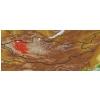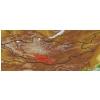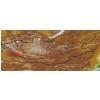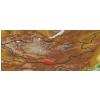| Class: | angiosperms |
| Order: | Solanales |
| Family: | Solanaceae |
| Genus: | Lycium |
| Scientific name: | Lycium ruthenicum Murr. |
| Name acc. to: | Gubanov 1996 |
| Herbar: | list records |
| Link to Flora of China: | http://www.efloras.org/browse.aspx?flora_id=2&name_str=Lycium+ruthenicum |
| open map in a new window |  |
| Habitat: | Puffy and clayey solonchaks, toyrims, sondoks, dry beds and deltas of sayrs, tugai forests, alkaline banks of rivers and irrigation ditches, lake coasts, near springs, abandoned fields, salinized screes (Grubov 2001). |
| Habit (i)general appearance of a plant | |
| Growth form: (i)Herb, shrub, tree or climber. | shrub, subshrub or semishrub (i)Shrub, multi-stemmed, mostly (0.2) 0.5 - 5 m high, shoots woody up to the tip
example: Caragana leucophloea   inherited by genus Lycium: shrub, subshrub or semishrub inherited by genus Lycium: shrub, subshrub or semishrub
|
| Parasite status: (i)Is the plant a half- or full parasite? | no parasite/saprophyte (i)Plant fully autonomous, leaves with chlorophyll
example: Most plants, Ranunculus  inherited by family Solanaceae: no parasite/saprophyte inherited by family Solanaceae: no parasite/saprophyte
|
| Water or terrestrial plant: (i)Where do the plants grow? | terrestrial (i)Plant grows on dry land
example: Orostachys spinosa  inherited by family Solanaceae: terrestrial inherited by family Solanaceae: terrestrial
|
| Leaf (i)expanded, usually photosynthetic organ of a plant (including phylloclades) | |
| Leaf development: (i)Structure and development of leaves. | with green leaves (i)Plant with green leaves  inherited by family Solanaceae: with green leaves inherited by family Solanaceae: with green leaves
|
| Leaf arrangement: (i)Arrangement of leaves at the stem. | alternate (i)One leaf per node; distiche: arranged in two vertical rows, equitant
example: Phragmites    inherited by family Solanaceae: alternate inherited by family Solanaceae: alternate
|
| Leaf veination: (i)Arrangement of the main veins of a leaf. | pinnate (i)One main vein, several side veins, sometimes inconspicuous
example: Cicerbita     inherited by family Solanaceae: pinnate inherited by family Solanaceae: pinnate
|
| Flower (i)reproductive portion of the plant, consisting of sepals, petals, stamens, and pistils | |
| Flower appearance and pollination: (i)General appearance of the flower. | attractive, animal-pollinated (i)attractive and coloured flowers, mostly large, attracting surely animals
example: Trollius, Rosa, Chamaerhodos  inherited by family Solanaceae: attractive, animal-pollinated inherited by family Solanaceae: attractive, animal-pollinated
|
| Perianth arrangement: (i)Attention: in some plants, flowers may be dimorphic in different ways (dioecious or gynodioecious). If flowers vary, record the characters of the most showy flowers. | double, different (i)Two types of perianth leaves, differently coloured (sepals: outer periant leaves, usually greenish, and petals: inner perianth leaves, usually coloured)
example: Parnassia    inherited by family Solanaceae: double, different inherited by family Solanaceae: double, different
|
| Flower symmetry: (i)Symmetry of the perianth leaves. Attention: to assess this character, look on sepals, petals and stamens, but neglect carpels and ovary. | radiary, regular (actinomorphic) (i)More than two axis of symmetry
example: Saxifraga: 5; Iris: 3   inherited by family Solanaceae: radiary, regular (actinomorphic) inherited by family Solanaceae: radiary, regular (actinomorphic)
|
| Flower form: (i)common forms of flowers ? Veronica | simple (flat) - Do not confuse with inflorescences as in some Asteraceae (i)Petals spread out, flower appearing flat
example: Mollugo, Trientalis, Pulsatilla, Saxifraga   inherited by family Solanaceae: simple (flat) - Do not confuse with inflorescences as in some Asteraceae inherited by family Solanaceae: simple (flat) - Do not confuse with inflorescences as in some Asteraceae
campanulate (i)Petals united to a bell-shaped corolla   inherited by family Solanaceae: campanulate inherited by family Solanaceae: campanulate
|
| Sepal number: (i)Number of sepal leaves (outer perianth leaves, calyx leaves, mostly greenish). Attention, this character applies only for flowers separated in sepals and petals, thus excluding most monocots. Be aware of the bracts (involucral leaves) of Asteraceae flowerheads, do not qualify these as sepals! Be also aware in Rosaceae is often an epicalyx developed, in this case count all parts. | 5 (i)
example: Polemonium  inherited by family Solanaceae: 5 inherited by family Solanaceae: 5
|
| Sepal fusion: (i)To which degree are the sepal leaves connected? Attention, this character applies only for flowers separated in sepals and petals, thus excluding most monocots. Be aware of the bracts (involucral leaves) of Asteraceae flowerheads, do not qualify these as sepals! | fused (i)Leaves united, only tips are free
example: Fabaceae, Silene    inherited by family Solanaceae: fused inherited by family Solanaceae: fused
|
| Petal / Tepal number: (i)Number of petal leaves (inner perianth leaves, usually coloured). | 5 (i)
example: Potentilla  inherited by family Solanaceae: 5 inherited by family Solanaceae: 5
|
| Petal / Tepal fusion: (i)To which degree are the petal leaves connected? Petals sympetalous. | fused (i)petal leaves united, only tips are free (gamopetalous, sympetalous)
example: Linnaea, Adenophora, Stellera  inherited by family Solanaceae: fused inherited by family Solanaceae: fused
|
| Spur: (i)A hollow, slender, sac-like appendage of the perianth leaves, storing nectar. | no spur (i)Flower without appendage
example: Peganum  inherited by family Solanaceae: no spur inherited by family Solanaceae: no spur
|
| Stamen number: (i)Attention: We ask for the reproductive organs of the flower dispersing pollen. Count only fully fertile stamens, not staminodia (e.g. Parnassia). | 5 (i)
example: Peucedanum  inherited by family Solanaceae: 5 inherited by family Solanaceae: 5
|
| Stamen fusion: (i)To which degree are the stamens fused? Attention: Whereas the pollen sacs itself are often free., their stalks (filaments) may be fused. Here, we count them as fused if they are together over at least one thirth of their length. | free (i)Stamens with separate bases
example: Malus  inherited by family Solanaceae: free inherited by family Solanaceae: free
|
| Pistil number: (i)Number of pistils (female floral organs: style, if developed; stigma and carpels/ovary together build the pistil). | 1 (i)One carpel, but clearly one stigma
example: Pyrola, Primula, Alyssum  inherited by family Solanaceae: 1 inherited by family Solanaceae: 1
|
| Carpel number: (i)Number of carpels (carpel: forming a simple pistil or part of a compound pistil, modified leaf). | 2  inherited by family Solanaceae: 2 inherited by family Solanaceae: 2
|
| Carpel fusion: (i)To which degree are the carpels (modified leaf forming simple pistil or part of a compound pistil) fused. | fused (i)Carpels united into an ovary, only styles are free
example: Malus, Berberis  inherited by family Solanaceae: fused inherited by family Solanaceae: fused
|
| Style number: (i)Portion of the pistil connecting the stigma to the ovary. | 1  inherited by family Solanaceae: 1 inherited by family Solanaceae: 1
|
| Stigma number per style: (i)Number of stigmas per style. | 1 (i)One stigma, sessile or with a developed style  inherited by family Solanaceae: 1 inherited by family Solanaceae: 1
|
| Ovary position: (i)For entirely or partly fused carpels, describe their position in relation to the insertion point of perianth leaves (best done by doing a longitudinal section of a flower). | superior (hypogynous) (i)Base of carpels attached above insertion point of perianth leaves, carpels free or fused
example: Delphinium, Anemone    inherited by family Solanaceae: superior (hypogynous) inherited by family Solanaceae: superior (hypogynous)
|
| Sex: (i)Distribution of male and female organs among flowers, only most commonly cases. | bisexual, hermaphrodite (i)All or nearly all flowers of a plant with male and female parts
example: Haplophyllum, Chenopodium  inherited by family Solanaceae: bisexual, hermaphrodite inherited by family Solanaceae: bisexual, hermaphrodite
|
| Inflorescence (i)flowering part of a plant, describes the arrangement of the flowers on the flowering axis | |
| Inflorescence: (i)Structure of the inflorescence. | Flowers in inflorescence (i)No solitary flowers  inherited by genus Lycium: Flowers in inflorescence inherited by genus Lycium: Flowers in inflorescence
|
| Appearance: (i)Outer look of the inflorescence. | axillary (i)Usually several inflorescences in axillary shoots or single flowers in leaf axils, main shoot remains mostly leafy
example: Tragopogon, Aconogonon  inherited by genus Lycium: axillary inherited by genus Lycium: axillary
|
| Fruit (i)the seed bearing organ, with or without adnate parts; a ripened ovary and any other structures which are attached and ripen with it. Aggregate fruits are handled like simple fruits for determination. | |
| Consistency: (i)Fleshy fruits or dry fruits, see dispersal adaptations for further classification. | fleshy (i)Usually non dehiscent; with a fleshy (swollen because of a high water content) outer shell, flesh edible at least for animals
example: Prunus, Amygdalus, Malus  inherited by genus Lycium: fleshy inherited by genus Lycium: fleshy
|
| Type of fruit: (i)Common fruit types (including pseudocarp). | Indehiscent fruits  inherited by genus Lycium: Indehiscent fruits inherited by genus Lycium: Indehiscent fruits
Solitary fruits (i)     inherited by genus Lycium: Solitary fruits inherited by genus Lycium: Solitary fruits
berry (i)Fleshy fruit with several to many seeds in the flesh
example: Tomato   inherited by genus Lycium: berry inherited by genus Lycium: berry
|
| Opening of fruit: (i)Mode of dehiscence at maturity to release seeds. | not opening / indehiscent (i)Fruits remain closed at maturity and disperse with seeds inside
example: Corylus (nut), Vaccinium (berry)  inherited by genus Lycium: not opening / indehiscent inherited by genus Lycium: not opening / indehiscent
|
| Shoot/Stem (i)a young stem or branch | |
| Spines, thorns or prickles: (i)Shoot with conspicuous spines, thorns or prickles. | spines or thornes (i)Sharp pointed woody structure originating from the plant (thornes derived from a reduced branch, spines from leaves)
example: Prunus spinosa no in Mongolia  inherited by genus Lycium: spines or thornes inherited by genus Lycium: spines or thornes
|
| Root / shoot below ground (i)plant part below ground (in most cases), including below ground shoots, without leaves | |
| Root type: (i)Organisation of the roots. | allorhizous (i)Plant with a conspicuous tap root, one larger tap root with side roots
example: Dicotyledonae  inherited by order Solanales: allorhizous inherited by order Solanales: allorhizous
|
| Distribution (i)region where the plant is likely to be found | |
| Distribution (Veg. Zones): (i)acc. to Grubov 1952 | Depression of Great Lakes (i)In distribution data often named as '10' 
Valley of Lakes (i)In distribution data often named as '11' 
Gobi-Altai (i)In distribution data often named as '13' 
Dzungarian Gobi (i)In distribution data often named as '14' 
Transaltai Gobi (i)In distribution data often named as '15' 
Alashan Gobi (i)In distribution data often named as '16' 
acc. to: Gubanov 1996 |